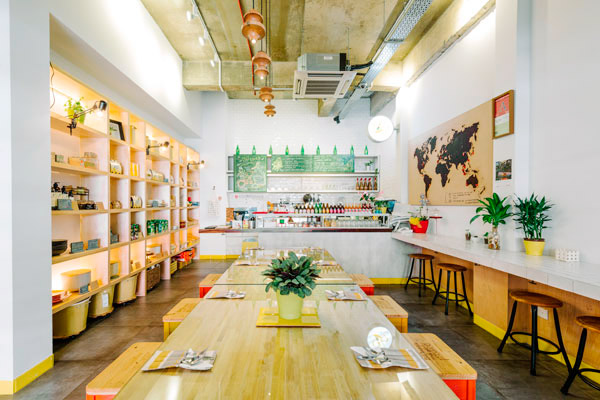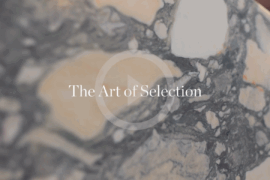Enviro Tec offers up an industrial aesthetic for Loving Hut’s latest outpost in Singapore, writes Christie Lee.

October 7th, 2014
Singapore has long been the breeding ground for stylishly modern vegan restaurants. The latest to set up shop in the country? Loving Hut Singapore.
Founded by Ching Hai, a Vietnamese spiritual leader and founder of the Supreme Master Ching Hai International Association, Loving Hut is one of the largest vegan restaurant collectives in the world, boasting over 200 outlets in five continents. The vegan chain professes to take a holistic approach to life, serving only 100 per cent plant-based dishes, with ingredients sourced locally and from neighbouring countries to minimise the carbon footprint.
Nested among a hodgepodge of Peranakan shophouses, art spaces and small businesses, Loving Hut Singapore enjoys prime spot on colourful Joo Chiat Road.
For this project, Indonesia-based design firm Enviro Tec has conceived a space that is high on style, and smart in the way that locally-sourced materials are used.
The 325-metre-square restaurant is divided into two areas: a communal and a more private dining area. While in the former, dining tables can be folded and re-assembled to allow for flexible seating arrangement, the latter is dominated by loose chairs and cove benches. For those wishing to enjoy a contemplative moment from the hustle and bustle of city life, stools that are lined up against the wall counters beckons.
Vintage white ceramic tiles make for a welcoming atmosphere at the cash counter. A nifty shelf behind puts the vast array of vegan products on display – a sentiment echoed perhaps, in the array of lush potted plants that are placed generously around the space. The restaurant is also blessed with high ceilings, allowing food aromas to waft through the air without overpowering the human senses.
Light-toned rubber wood, plywood and exposed concrete slab combine for a raw-meets-refined aesthetic. Industrial lighting casts a warm glow over the space, while timber furniture, dressed up in woven upholstery that is made from organic cotton, provides patrons with a cosy environment to dine in. The utensil holders, coaster clothes and staff’s apron pockets are made from the same cotton material. Dining tables are sparsely yet stylishly decorated, and the vegan chain’s slogan “Be vegan and make peace” is inked on select surfaces including postcards and coasters.
The walls are awash in yellow and feature a salvo of contemporary artworks by local and Indonesian artists. An illuminated signage, which spells out “Vegan & Love”, is hoisted up on the wall. Next to it, a world map charts out all the Loving Hut restaurants in the world.
A French bistro-styled canopy, constructed from resilient grey cloth, is installed at the five-foot-walkway at the back of the restaurant. It’s a smart way to mediate between the man-made and natural environments, the latter having been converted into a public alfresco area where patrons can mingle over soy milk-based latte and bread pudding while taking in the great outdoors.
Enviro Tec
et-envirotec.com
INDESIGN is on instagram
Follow @indesignlive
A searchable and comprehensive guide for specifying leading products and their suppliers
Keep up to date with the latest and greatest from our industry BFF's!

CDK Stone’s Natasha Stengos takes us through its Alexandria Selection Centre, where stone choice becomes a sensory experience – from curated spaces, crafted details and a colour-organised selection floor.

Rising above the new Sydney Metro Gadigal Station on Pitt Street, Investa’s Parkline Place is redefining the office property aesthetic.

Merging two hotel identities in one landmark development, Hotel Indigo and Holiday Inn Little Collins capture the spirit of Melbourne through Buchan’s narrative-driven design – elevated by GROHE’s signature craftsmanship.

London-based design duo Raw Edges have joined forces with Established & Sons and Tongue & Groove to introduce Wall to Wall – a hand-stained, “living collection” that transforms parquet flooring into a canvas of colour, pattern, and possibility.

Zenith Interiors has launched the Orbis work desk range, a refined and elegant solution for modern workspaces.
Vibe Furniture has 30 years experience providing loose furniture packages to the commercial market.
The internet never sleeps! Here's the stuff you might have missed

CDK Stone’s Natasha Stengos takes us through its Alexandria Selection Centre, where stone choice becomes a sensory experience – from curated spaces, crafted details and a colour-organised selection floor.

Good looks count, but function completes the space.